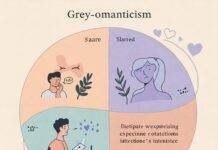“Millions worldwide navigate the complexities of attraction, and when it comes to romance, the spectrum is broader than many realize. Understanding the difference between grey-romantic vs aromantic identities is crucial for self-discovery and fostering inclusivity. While both relate to experiencing romantic attraction differently from the norm, they occupy distinct positions on the aromantic spectrum. Let’s delve into the nuances of grey-romantic vs aromantic experiences.”.

Defining Aromantic: The Absence of Romantic Attraction
At its core, aromatic (often shortened to “aro”) describes individuals who experience little to no romantic attraction towards others. This isn’t a choice; it’s an inherent aspect of their identity. For aromatic individuals, the desire for romantic relationships, as typically portrayed in society, may simply not exist or hold little importance.
- Lack of Romantic Feelings: Aromantic individuals generally don’t develop romantic feelings for others, regardless of gender, sex, or other factors.
- Distinction from Asexuality: It’s important to note that being aromatic is distinct from being asexual, which refers to a lack of sexual attraction. Someone can be aromatic and sexual, asexual and romantic, both, or neither.
- Diverse Experiences within Aromanticism: Even within the aromatic community, experiences vary. Some aromatic individuals may enjoy romantic tropes in fiction but not desire them in real life, while others may find the concept unappealing altogether.
(Outbound Link: Link to a reputable website explaining aromanticism, e.g., The Aromantic-spectrum Union for Recognition, Education, and Advocacy (AUREA))
Exploring Grey-Romantic: Experiencing Romantic Attraction Rarely or Weakly
Grey-romantic individuals, on the other hand, fall somewhere on the spectrum between romantic and aromatic. They experience romantic attraction, but it’s infrequent, weak, or under specific circumstances. The “grey” signifies the less clear-cut experience compared to those who consistently feel romantic attraction.
- Infrequent Attraction: For some grey-romantic individuals, romantic attraction might only occur very rarely in their lives.
- Weak or Ambiguous Feelings: Others might experience feelings that are difficult to categorize as definitively “romantic,” feeling faint or fleeting.
- Situational Attraction: Some grey-romantic individuals might only experience romantic attraction under very specific conditions or after a deep emotional connection has formed.
- Demisexuality as a Subset: Demisexuality, where romantic attraction only develops after a strong emotional bond, is often considered a subset of the grey-romantic umbrella.

Key Differences: Frequency, Intensity, and Clarity
The primary distinction between grey-romantic and aromatic lies in the experience of romantic attraction. Aromatic individuals generally do not experience it, while grey-romantic individuals do, albeit in a limited or nuanced way.
| Feature | Aromantic | Grey-romantic |
|---|---|---|
| Romantic Attraction | Little to none | Experienced rarely, weakly, or conditionally |
| Frequency | Generally absent | Infrequent or specific to certain situations |
| Intensity | Typically not felt | Often weak or ambiguous |
| Clarity | Clear lack of romantic feelings | Feelings may be confusing or hard to identify as romantic |
Export to Sheets
Why Understanding the Aromantic Spectrum Matters
Recognizing the nuances between grey-romantic and aromatic identities is crucial for several reasons:
- Validation: It helps individuals who don’t fit neatly into traditional romantic experiences feel seen and validated.
- Community: Understanding these terms allows people to find communities where their experiences are shared and understood.
- Building Healthier Relationships: For those in relationships with grey-romantic or aromatic individuals, it fosters better communication and realistic expectations.
- Challenging Norms: It broadens our understanding of love and relationships beyond the conventional romantic narratives.
(Outbound Link: Link to an article or resource discussing the importance of understanding the aromantic spectrum, perhaps from an LGBTQ+ advocacy group.)
Navigating Your Own Identity
If you find yourself questioning your experiences with romantic attraction, exploring the aromatic and grey-romantic spectrum can be a helpful journey. Remember:
- Self-discovery is a process: It’s okay to take time and explore different labels that resonate with you.
- Your feelings are valid: Whether you identify as aromatic, grey-romantic, or something else entirely, your experiences are real and valid.
- There’s a community for you: Numerous online and offline communities exist for aromatic and grey-romantic individuals.

Conclusion: Embracing the Diversity of Romantic Experience
The spectrum of romantic attraction is vast and varied. Understanding the distinctions between grey-romantic and aromatic identities allows for greater self-awareness, stronger communities, and a more inclusive understanding of how people experience relationships. By embracing this diversity, we can create a world where everyone feels seen and validated in their unique experiences of love and connection.




































